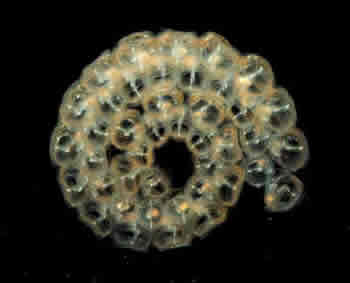Our nets catch a wide variety of creatures. This summer the fastest growing, the most widespread, and the most abundant of the planktonic animals is the Salpa thompsoni, or just salps to their friends. Salps are an open ocean tunicate, an animal  composed of a gelatinous tube that sucks water in one end and propels it out the other after passing it over a mucus membrane that vacuums it clean of all edible material. Everything that is caught is moved over to a small sphere containing the digestive and reproductive organs. That's basically its life plan: it squirts, consumes and reproduces. Salp sex, however, is a little unusual. In the summer, solitary salps bud off hundreds of clones in long chains without the need of a partner. The buds grow rapidly in size as they Hoover the sea in vast clouds. They're also hermaphroditic -- an individual is both female and male -- and this generation reproduces sexually, either with itself or by filtering sperm broadcast from one of its neighbors. Each bud will harbor a single embryo which will then over-winter and begin budding the following spring.
composed of a gelatinous tube that sucks water in one end and propels it out the other after passing it over a mucus membrane that vacuums it clean of all edible material. Everything that is caught is moved over to a small sphere containing the digestive and reproductive organs. That's basically its life plan: it squirts, consumes and reproduces. Salp sex, however, is a little unusual. In the summer, solitary salps bud off hundreds of clones in long chains without the need of a partner. The buds grow rapidly in size as they Hoover the sea in vast clouds. They're also hermaphroditic -- an individual is both female and male -- and this generation reproduces sexually, either with itself or by filtering sperm broadcast from one of its neighbors. Each bud will harbor a single embryo which will then over-winter and begin budding the following spring.
When conditions are right the salp population can increase 1000 times from one year to the next, and then decline just as rapidly. This happens perhaps two years out of five and we refer to these as salp years. During a salp year the number of other species common in the plankton is reduced by two-thirds, the water is clear as sea algae is consumed as fast as it can grow, and krill can't find enough to eat to sustain their reproduction.
This is one of those years. Earlier this month the buds were no larger than 1/2"; now the biggest are several inches and new ones are produced each day. They dominate the catches everywhere we sample and as they grow their weight becomes ponderous. Because they're mostly water, however, they aren't very attractive as food for the penguins, seals and whales that normally feed on krill.
We humans don't appreciate salps either, which have the consistency of a large, clear goober -- with a dark brown ball imbedded at one end. They clog the nets and expand a typical catch from a quart in volume to several gallons. They triple the work of finding the other animals in the sample and they themselves must be sorted, sized, counted and disposed of. After dealing with this growing menace, station after station, the biologists are a little whacked out. The population is still growing and they're worried that next month's survey could bury them.